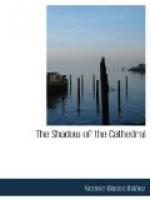And he led him to the High Altar by the Custodia. Gabriel and eight other men crept inside the scaffolding, raising the cloth with which its sides were covered. They were obliged to bend themselves inside the erection, and their duty was to push it, so that it should move along on its hidden wheels. Their only duty was to push it; outside, the two servants in black clothes and white wigs were in charge of the front and back shaft or tiller, which guided the eucharistic car through the tortuous streets. Gabriel was placed by his companions in the centre; he was to warn them when to stop and when to recommence their march. The monumental Custodia was mounted on a platform with a great counterpoise, and between it and the framework of the car was about a hand’s breadth of space, through which Gabriel looked, thus transmitting the orders of the front pilot.
“Attention! March!” shouted Gabriel, obeying an outside signal.
And the sacred car began to move slowly down the inclined wooden plane that covered the steps of the High Altar. It was obliged to stop on passing the railings. All the people knelt, and Don Antolin and the Wooden Staffs having opened a way between them, the canons advanced in their ample red robes, the auxiliary bishop with his gilded mitre, and the other dignitaries in white linen mitres without ornament whatsoever. They all knelt around the Custodia. The organ was silent, and, accompanied by the hoarse blare of a trombone, they intoned a hymn in adoration of the Sacrament; the incense rose in blue clouds around the Custodia, veiling the brilliancy of its gold. When the hymn ceased the organ began to play again, and the car once more resumed its march. The Custodia trembled from base to summit, and the motion made a quantity of little bells hanging on to its Gothic adornments tinkle like a cascade of silver. Gabriel walked along holding on to one of the crossbeams, with his eyes fixed on the pilots, feeling on his legs the movements of those who pushed this scaffolding, so similar to the cars of Indian idols.
On coming out of the Cathedral by the Puerta Llana, the only door in the church on a level with the street, Gabriel could take in the whole procession at a glance. He could see the horses of the Civil Guards breaking the regularity of the march, the players of the city kettledrums dressed in red, and the crosses of the different parishes grouped without order round the enormous and extremely heavy banner of the Cathedral, like a huge sail covered with embroidered figures. Beyond, all the centre of the street was clear, flanked on either side by rows of clergy and soldiers carrying tapers, the deacons with their censers, assisted by the roccoco angels carrying the vessels for the Asiatic perfume, and the canons in their extremely valuable historical capes. Behind the sacrament were grouped the authorities, and the battalion of cadets brought up the rear, their muskets on their arms, their shaven heads bare, keeping step to the time of the march.




